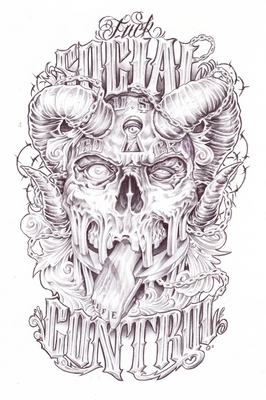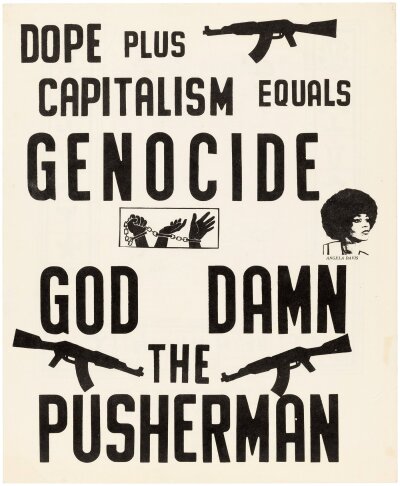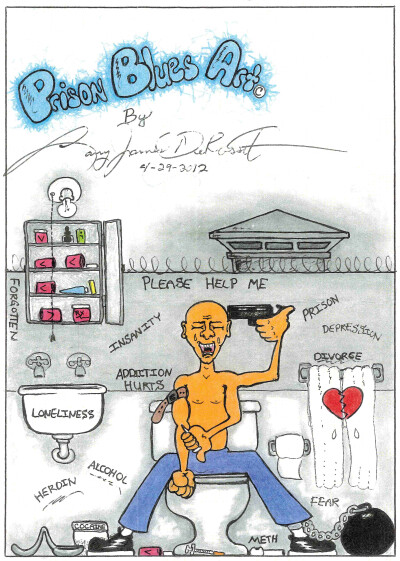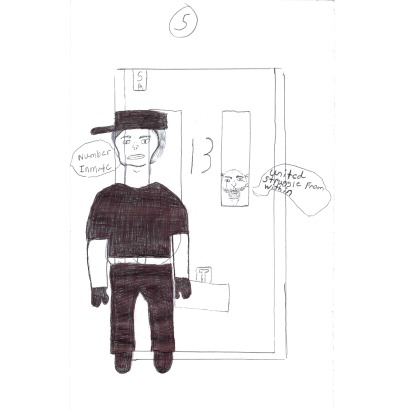
Tipless Spear: An Analysis of the Prison Movement Through the Lens of Michigan Prisons

A Juxtaposition to the Works of Orisanmi Burton
A spear, utilized as a weapon to engage in battle, can only be effective insofar as its tip is both sturdy and sharp. And the sharpness of its tip is maintained as part of a process of sharpening in the continuum of a protracted struggle campaign. Otherwise, what you’ll have is not an implement for war, but a stick that merely rhetorically projects a technology for combat that in actuality, is incapable of immobilizing or pushing back against a harmful, even deadly force. So considering the condition of the spear, I have no intention to deal with or re-visit the “Long Attica Revolt” with historicism, relegating the event to a time in history; nor to romanticize its existence for the purposes of psycho-emotional or intellectual masturbation. Instead, I relocate the Long Attica Revolt to the present moment in hopes of creating dialogue and theory around the fundamental question of whether the “Long Attica Revolt” (i.e the prison movement) still exists?
I start my analysis of the question at the end and (epilogue) of Orisanmi Burton’s (hereinafter Ori) text with the statement:
“For many, 1993 was a watershed in the slow disintegration of the prison movement.”(1)
If 1993 marked the crucial turning point in which the prison movement started dissipating, or decomposing, what does the reality look like in 2024, 31 years after its evocation? If we are serious about “interpreting the world to change it, there is no escape from historical materialism,”(2) requiring my analysis to stay anchored to tackle the question from my direct experience as a prisoner of 21 and a half consecutive years of carceral bondage within Michigan prisons. In so doing, I stay true to Mao’s injunction to adhere to what [Vladimir] Lenin called the “most essential thing in Marxism, the living soul of Marxism, [the] concrete analysis of concrete conditions.”(3)
The “prison movement,” according to the New Afrikan analysis that I subscribe to, marked a specific moment in time that spearheaded a qualitative change, transforming issue-based prison struggles centered primarily around conditions of confinement (reform), into a movement that was influenced by and married itself to the anti-colonial national liberation struggles being waged beyond the concrete walls (revolutionary). These circumstances, having affected colonial people on a world scale, radicalized and politicized sections of the colonial subjects in the united states to such an extent where the consciousness developed inside of penal dungeons was being disseminated to the streets where it would be internalized and weaponized by agents against the state. The impetus for this qualitative leap in the substance and character of the prison movement was Johnathan Jackson’s 7 August 1970 revolutionary act of pursuing the armed liberation of the Soledad Brothers, culminating in the 9 September 1971 Attica Rebellion. This is why Ori argued the “Long Attica Revolt was a revolutionary struggle for decolonization and abolition at the site of US prisons.”(4)
While Ori’s assessment may have been correct, his very own analysis, and a concomitant analysis of present-day Michigan, exposes a revolutionary contradiction prone to reversion and therefore revolutionary (Marxist) revision by elements that were, in fact, never revolutionary or abolitionist but only radical reformist. Revisionism spells doom (death) to the prison movement, so part of our objective has got to be how do we oppose the carceral state from an ideological and practical perspective to ensure the survival of a dying prison movement, and reap benefits and successes from our struggle. After all, Ori tells us the aim of his book is “to show that US prisons are a site of war, [a] site of active combat.”(5)
Clausewitz (Carl von) observed that war was politics by other means, just as Michel Foucault reasoned politics was war by other means. War and politics being opposite sites of a single coin, this “COIN” in military jargon is none other than “counterinsurgency.” As explained in the U.S. Army Field Manual at 3-24. It defines insurgency as:
“an organized, protracted politico-military struggle designed to weaken the control and legitimacy of established government, occupying power, or other political authority while increasing insurgent control.”
“The definition of counterinsurgency logically follows:”Counterinsurgency is the military, paramilitary, political economic, psychological, and civic actions taken by a government to defeat insurgency.””
“Counterinsurgency, then, refers to both a type of war and a style of warfare”(6), whose aim is, in the context of prisons, to neutralize the prison movement and the ability of its agency to build the movement into the future.
As we can see, by isolating and extracting this point from Ori’s text, u.s. prisons as combat zones where war is waged is significant if we are to gleam from this fact what the proponents, the protagonists of the prison movement must do next; how we struggle accordingly in hopes of gaining victories.
The Master Plan
The logical response of a revolutionary tactician to state repression is resistance. But not just resistance for the sake of being recalcitrant – as Comrade George (Jackson) informed us, our fight, our resistance has to use imagination by developing a fighting style from a dialectical materialist standpoint. Because
“…we can fight, but if we are isolated, if the state is successful in accomplishing that, the results are usually not constructive in terms of proving the point. The point is, however, in the face of what we confront, to fight and win. That’s the real objective: not just make statements, no matter how noble, but to destroy the system that oppresses us.”(7)
In constructing long-term insurgency repression (counterinsurgency), the scientific technology deployed by the state was “soft power” as its effective mechanism to accomplish their task. Ori tells us the federal government drafted a “Master Plan” which hinged on “correctional professionals coming to realize that the battle is won or lost not inside the prison, but out on the sidewalks.”(8) This assessment could only be true considering the question surrounding prisons and the corollary prison movement is one of legitimacy, for only through legitimacy could the state preserve carceral normalcy. So counterinsurgency, or war, to be overtly specific, and the game is the acquisition of legitimacy from the masses (national public at-large) as a main objective. This fact should be telling that the struggle for state oppression, aggression and repression within the context of the prison movement is ultimately always a struggle for the people. Thus, “in an insurgency, both sides rely on the cooperation of the populace; therefore they compete for it, in part through coercive means.”(9) These political facts, as tactics of war, envision the real terrain in which the battle for prison lives is waged: the mental realm. It is within this domain that resistance and the legitimacy on both sides of the barb wired cage will be won.
The prisoner population must take cues from these facts. The very first recognition has got to be that prisons, deployed as war machines, cannot possibly be legitimate if we (the prisoners) have been cast as the enemies the state seeks to annihilate as human beings by re-converting us from second-class citizens back to slaves. This was the very point Ori lets us in on regarding Queen Mother Moore’s August 1973 visit and speech in Green Haven Prison in New York, that New Afrikans were in fact enduring “re-captivity.”(10) Blacks have long hoisted this argument, lamenting an amendment to the 13th Amendment to the u.s. constitution, and a host of case law, like the case of Ruffin v Commonwealth cited by Ori, have declared “incarcerated people slaves of the state.”(11) And as slaves, to borrow the words of George, “the sole phenomenon that energizes my whole consciousness is, of course, revolution.” In this vein the prison movement is partially about the survival of the humanity of prisons, their dignity, which requires the survival of the spirit of the prison movement. This is what Chairman Fred Hampton meant when he said “You can kill a freedom fighter, but you can’t kill freedom fighting. You can kill a revolutionary, but you can’t kill revolution.” It is this very same deprivation of human dignity that Huey talked about resulting in what I’m experiencing among Michigan prisoners, who are largely “immobilized by fear and despair, he sinks into self-murder”.(12) But even more dangerous to Huey than self-murder, is spiritual death, what Huey witnessed become a “common attitude… driven to death of the spirit rather of the flesh.”
So the very idea (spirit) of the prison movement must survive, must be kept alive, or, “your method of death can itself be a politicizing thing.”(13). And this is precisely the reality Michigan’s male prisoners have succumbed to, death of spirit, death by de-politicization.
All this begs the question posed by George: What is our fighting style in face of political death? This question can only be answered against the background of the statement: “For many, 1993 was a watershed in the slow disintegration of the prison movement,” because the reality shouts out to us that the prison movement has diminished to such a degree, it’s in desperate need of being incubated back to life (if it still exists at all).
Thus far it has been made clear that at issue is the survival of the prison movement which means by extension a revival of the political life of prisoners. The catalyst breeding political consciousness can only be education. As Ori illuminates, part of the prisoner war project requires guerrilla warfare, the life of which itself is grounded in political education.(14) Ori himself writes in the acknowledgment section of Tip of the Spear that he sharpened his spear (political analysis) by tying himself to a network of intellectuals and study groups, like Philly-based podcast Millenials Are Killing Capitalism.
The Role of Outside Supporters
The “Master Plan” developed by the state concluded “that the battle is won or lost not inside the prison, but out on the sidewalks,” and this leads directly to the utility of individuals and organizations outside the confines of prison life to be leveraging against the subjects inside the walls. Yet, it must not be lost upon us that by virtue of the state’s “Master Plan”, they seek to weaponize outside organizations as tools to drive a nail in the coffin of the prison movement once and for all. Proponents of the prison movement, accordingly, must also utilize and weaponize outside agency to advance the prison movement. When asked, although George said, “A good deal of this has to do with our ability to communicate to people on the street,” we must nevertheless be sure not to allow this communication or the introduction of outside volunteers to stifle the spirit of the movement.
Ori hits the nail on the head when exposing the “Master Plan” to absorb outside volunteers as part of the “cynical logic of programmification, with well-meaning volunteers becoming instruments of pacification.”(15) I spoke to this very phenomena in 2021 essay entitled “Photograph Negatives: The Battle For Prison Intelligentsia”, in response to a question posed to me by Ian Alexander, an editor of True Leap Press’s “In The Belly” publication, on whether outside university intellectuals could follow the lead of imprisoned-intellectuals? There I mentioned how Michigan’s outside volunteers near absolute adherence to prison policy, designed to constrain and be repressive, retarded our ability to be subversive and insurgent, called into question the purpose of the university-intellectuals infiltration of the system in the first instance. And while “many of these volunteers undoubtedly had altruistic and humanitarian motives, they unwittingly perpetuated counterinsurgency in multiple ways.”(16)
The battle for prison intellgentsia itself creates an unspoken tension between the inside (imprisoned) and outside (prison) intellectuals to the detriment of the prison movement, benefiting the state’s “Master Plan.” As I cited in “Photograph Negatives,” Joy James correctly analyzes that it is the imprisoned intellectuals that are “most free of state condition.” Scholar Michel-Rolph Troillot’s insight also champions that imprisoned intellectuals, “non-academics are critical producers of historiography,”(17) yet, as Eddie Ellis told Ori during a 2009 political education workshop, “We have never been able to use the tools of academia to demonstrate that our analysis is a better analysis.”(18) This fact further substantiates my position in response to editor Ian Alexander that outside university-based intellectuals must take their lead from imprisoned intellectuals because (1) we are the experts, validated through our long-lived experiences; and (2) most university-intellectuals are clueless they’re being used as tools within the state’s “Master Plan” against the very prisoners that altruism is directed.
Carceral Compradors Inside
But sadly, it’s not just the outside volunteers being positioned as pawns in the state’s war against prisoners. To be sure, prisoners themselves have become state agents, be it consciously or unconsciously, pushing pacification through various behavioral modification programming that intentionally depoliticizes the prisoner population, turning them into do-gooder state actors. It is in this way that the prison state “strategically co-opted the demands of the prison movement and redeployed them in ways that strengthened their ability to dominate people on both sides of the wall.”(19)
In Michigan prisons, these compromised inmates function as “carceral compradors,” and part of the plan of this de-politicizing regime is to convince the prisoner population to surrender their agency to resist. It has been the state’s ability to appease these, what Ricardo DeLeon, a member of Attica’s revolutionary committee, said was the elements of “all the waverers, fence sitters, and opponents,”(20) exacerbating already-existing fissures, exposing the deep contradictions between a majority reformist element, and the minority revolutionary element. This success effectively split and casted backward the “prison movement” to its previously issue-based conditions of confinement struggle model by “exposing a key contradiction within the prison movement, ultimately cleaving support from the movement’s radical edge while nurturing its accomodationist tendencies.”(21)
All of this was (is) made possible because “a sizable fraction of the population that saw themselves, not as revolutionaries, but as gangsters: outlaw capitalists, committed to individual financial gain”(22), and radical reformist, despite their rhetoric to the contrary, focused rather exclusively on conditions of confinement, instead of materializing a revolutionary goal. If the prison movement is a revolutionary movement, then the revolutionary element must manage to consolidate power and be the final arbitrators of the otherwise democratic decision-making processes. Ori cites Frantz Fanon to make clear that political parties serve as “incorruptible defenders of the masses,” or, the movement will find itself vulnerable to neocolonial retrenchment.(23) The schism that emerges between these two factions, ideologically, paralyzes the prison movement. These implications obviously extend beyond the domain of prisons to the collective New Afrikan struggle on the streets, as the prison movement was fostered by national liberation struggle on the outside, lending the credence to the victory from the sidewalk notion. But in order to secure a revolutionary party-line, the revolutionary party must be the majority seated element in the cadre committee.
Perhaps this is precisely why Sam Melville, a key figure in the Attica rebellion, said it was needed to “avoid [the] obvious classification of prison reformers.”(24) This is significant because otherwise, reformists would dominate the politics, strategies and decision-making, killing any serious anti-colonial (revolutionary) ideology. Again, this is true for both the inside and outside walkways. As a corollary, this reality should cause the revolutionary-minded to seriously rethink ways in which our struggle is not subverted from within the ranks of fighters against the state who, contradictorily, are okay with the preservation and legitimization of the prison machine and its “parent” global white supremacist structure, so long as remedial measures are taken to ameliorate certain conditions.
Our Road
In advance of summarizing, let me just say I do not at all intend to imply a reformist concession can’t be viewed as a revolutionary advancement within the overall scheme of carceral war. I pivot to Rachel Herzing, co-founder of Critical Resistance, that
“an abolitionist goal would be to try to figure out how to take incremental steps – a screw here, a cog there – and make it so the system cannot continue – so it ceases to exist – rather than improving its efficiency.”
But that’s just it. The Attica reforms did not, as Rachel Herzing would accept, “steal some of the PIC’s power, make it more difficult to function in the future, or decrease it’s legitimacy in the eyes of the people.” On the contrary, the Attica reforms entrenched the system of penal legitimacy, seeded the proliferation of scientific repression, and improved upon the apparatus’s ability to forestall and dissolve abolitionist resistance. In addition, the reforms were not made with the consent of the Attica revolutionaries, but by a splintering majority of radical reformers who, in the end, the present as our proof, greased by the levers of power assenting to the machine’s pick up of speed and tenacity.
As inheritors of the prison movement, and as we consider the de-evolution of the Long Attica Revolt and all it entails, specifically its survival, we are called upon to meditate on Comrade George’s essential ask – What is our fighting style? At minimum, I suggest our task is implementing a twofold platform: (1) political education; and (2) internal revolutionary development.
First, those equipped with the organization skills and requisite consciousness, as a methodology of guerilla war, should construct political education classes. These classes should operate within study group formats. We must return to the injunction of prisons functioning as universities, that “The jails (and prisons) are the Universities of the Revolutionaries and the finishing schools of the Black Liberation Army.”(25) We align ourselves with the Prison Lives Matter (PLM) formation model and utilize these study groups to engage in:
“a concrete study and analysis of the past 50+ years, and in doing so, We learn from those who led the struggle at the highest level during the high tide (1960s and 70s), where and how the revolutionary movement failed due to a lack of cadre development, as well as knowing and maintaining a line.”(26)
Our political education study groups must also instill a pride, courage, and will to dare to struggle along the lines of New Afrikan revolutionary ideology. For desperately, “Our revolution needs a convinced people, not a conquered people.”(27) The quality of courage in the face of impending brutality by what Ori calls the state’s “carceral death machine”(28) will be necessary to put in gear the wheels of guerrilla resistance. The invocation of this spirit sets apart the human prepared to demand and indeed take his dignity by conquest, from the weak, pacified slave who rationalizes his fear, which is in fact “symptomatic of pathological plantation mentality that had been inculcated in Black people through generations of terror.”(29) This terror in the mind of Black males inside of Michigan cages is displayed at even the mention of radical (revolutionary) politics, inciting a fear drawn from the epigenetic memory of chattel slavery victimization, and the propensity of master’s retaliatory infliction of a violent consequence. This thought has frozen and totally immobilized the overwhelming majority of Black Michigan prison-slaves, not just into inaction, but turning them into advocates of pacified slave-like mentalities. But these niggas are quick to ravage the bodies of other niggas.
To this point, Ori writes
“Balagoon suggests that the primary barrier to the liberation of the colonized was within their minds – a combination of fear of death, respect for state authority, and deference to white power that had been hammered into the population from birth. Liberation would remain an impossibility as long as colonized subjects respected the taboos put in place by their oppressors.”(30)
To be sure, liberation struggles can only be “successful to the extent that we have diminished the element of fear in the minds of black people.”(31) Biko, speaking to this fear as something that erodes the soul of Black people, recognized “the most potent weapon in the hands of the oppressor is the minds of the oppressed.”(32)
Secondly, hand-in-hand with our political education must be the material engagement in the first revolution, the inner revolution. This is “The hard painstaking work of changing ourselves into new beings, of loving ourselves and our people, and working with them daily to create a new reality.”(33) This first, inner-revolution consists of “a process of rearranging one’s values – to put it simply, the death of the nigger is the birth of the Black man after coming to grips with being proud to be one’s self.”(34)
The ability to transform oneself from a nigga to an Afrikan man of character is perhaps the most important aspect of developing concordance with a New Afrikan revolutionary collective consciousness. Commenting “On Revolutionary Morality” in 1958, Ho Chi Minh said that “Behavioral habits and traditions are also big enemies: they insidiously hinder the progress of the revolution.” And because niggas, unbeknownst to themselves are white supremacists and pro-capitalist opportunists, the vanguard security apparatus must forever remain on guard for the possibility of niggas in the rank-and-file corrupting the minds of other niggas who have yet to internalize New Afrikan identity.
May these be our lessons. Ori’s Tip of the Spear text is important in the overall lexicon on the history of the prison movement, and must be kept handy next to the collection of Notes From New Afrikan P.O.W and Theoretical Journals. Tip of the Spear should serve not just as reference book, but a corrective guide for the protagonist wrestling the prison movement out the arms of strangulation, blowing spirit into the nostrils of its decaying body until it’s revived, and ready to fight the next round. And We are that body. Let’s dare to do the work.
Forward Towards Liberation!
We Are Our Liberators!
^*Notes: 1. Orisanmi Burton, October 2023, Tip of the Spear: Black Radicalism, Prison Repression, and the Long Attica Revolt, University of California Press, p. 223 2. Praveen Jha, Paris Yeros, and Walter Chambati, January 2020, Rethinking the Social Sciences with Sam Moyo, Tulika Books, p.22 3. Mao Zedong, 1937, “On Contradiction”, Selected Works of Mao Tse-Tung 4. Burton, p.52 5. Burton, p.224-226 6. Life During Wartime, p.6 7. Remembering the Real Dragon - An Interview with George Jackson May 16 and June 29, 1971, Interview by Karen Wald and published in Cages of Steel: The Politics Of Imprisonment In The United States (Edited by Ward Churchill and J.J. Vander Wall). 8. Burton, p.175. 9. Life During Wartime, p.17. 10. Burton, p.1 11. Burton, p.10 12. Huey P. Newton, 1973, Revolutionary Suicide, p.4 13. Steve Biko, I write What I Like, p.150 14. Burton, p.4 15. Burton, p.179 16. Burton, p.175 17. Burton, p.8 18. Burton, p.7 19. Burton, p.150 20. Burton, p.41 21. Burton, p.150 22. Burton, p.99 23. Burton, p.92 24. Burton, p.82 25. Sundiata Acoli, “From The Bowels of the Beast: A Message,” Breaking da Chains. 26. Kwame “Beans” Shakur 27. Thomas Sankara Speaks: The Burkina Faso Revolution 1983-1987, p.417 28. Burton, p.105 29. Burton, p.42 30. Burton, p.42 31. Biko, p.145 32. Biko, p.92 33. Safiya Bukhari 34. Burton, p.62










